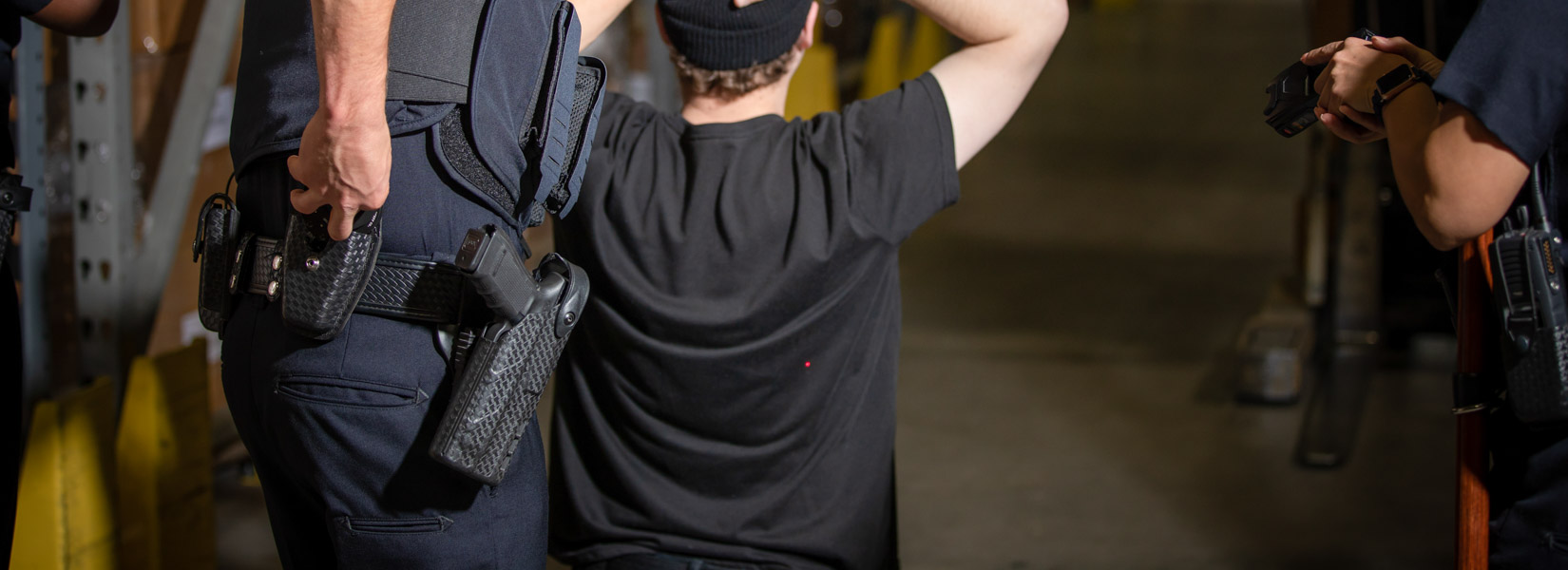Safariland purchased the Rogers Holster Company in 1985, and adopted a security rating system that had been developed by the Rogers Holster Company in early 80s. This system was based on a series of simple tests that could be conducted in the field by the end user.
Duty Rated LEVEL I RETENTION™
The Test is to simulate a “grab and snatch” initiated by an adversary. At the end of the 5 seconds, if the holster passes this initial test, it qualifies as a Duty Rated Level I Retention™ Security Holster.
- Apply all the force to the grip or handle of the weapon by an individual while the weapon is secured in the holster and mounted on a suitable belt being worn by another individual.
- The direction of force is unlimited but the duration of the force is limited to 5 seconds.
- Weapon must still be secure in the holster and the holster must still be attached to the operator.
- Operator must be able to accomplish a draw after the attack within the times set as a standard by the controlling department.
Duty Rated LEVEL II RETENTION™
Before a holster can be considered for a Duty Rated Level II Retention rating, it must first pass the Holster Retention Test. After passing the Test, the primary lock must be disabled and the same Test is repeated. In order to test the holster for a Level II rating, the primary securing device must be determined. The primary securing device is defined as the lock that requires the first action by the user in order to start the drawing sequence. This initial action is an individual and deliberate action by the user to start the unlocking of any securing mechanism.
- Determine Primary Securing Device
Example: Flipping back of the lever release of a Sentry device installed on a Safariland SLS™ (Self-Locking System) mechanism would be the first action required by the user, so the Sentry would be considered the primary securing device. In the case of an SLS without a Sentry, the hood must be pushed down and held in the down position but not pushed forward, as that would be a second required motion by the user. - The holster is tested with the initial lock disabled. It does not have to pass the complete test. Primary lock must be disabled and the same Test is repeated
- If the holster exhibits the ability to further secure the weapon in a meaningful way after the primary lock is disengaged then it qualifies as a Level II Retention security holster. If after disabling the initial lock, the holster can again completely pass the Holster Retention Test, then it is clearly rated as a Level II Retention and may qualify for additional levels of security.
The holster models 6390 and 7390 can be rated at Level II Retention by adding an ALS® Guard, a button/cover that sits over the ALS lever. It has two positions: back, covering the ALS; and forward, out of the way. It locks into either position and must be manually moved. It’s an excellent compromise because it allows the firearm to be positively locked into place by the ALS while creating a Level II Retention holster without the use of a strap. Typically, the ALS Guard is used in reverse, meaning the officer moves around with it in the forward (off) position most of the time. When a higher level of retention is desired, such as patrolling through a close, confined crowd, the officer moves the lever to the “on” position.
This holster model is still designated as a 6390/7390 but has an AG added to the end of the model number. For example: 7390-2832-411-AG. Before choosing this route, be sure your department will accept it. The written requirement may say Level II Retention, but when your new holster arrives, your department may say that their requirement was really an SLS strap.
Duty Rated LEVEL III+ RETENTION™
Before a holster can be considered for a Duty Rated Level III Retention rating or above, it must first receive a Level II Retention rating, and then be tested for additional levels of security.
- Determine the second motion or action required by the operator to continue the drawing sequence.
Example: In an SLS holster, the hood would be pushed down and then pushed forward in the final unlocked position before the test is performed. - The secondary lock must be disabled and the Test is repeated.
- If the holster passes a complete Test with the second lock disabled after the secondary lock is disabled, then it qualifies as a Level III Retention security holster. It can then be tested for further security levels by continuing to disable additional locks and conducting the same tests as outlined above.
The Level III Retention release sequence works in this series: first, push down, then flip forward on the SLS strap; next, come back with the thumb release and hit the ALS button to release the firearm, which is held under positive retention by the ALS lever. When you put the three moves together, they equate to three steps, thus Level III Retention.
Level III Retention holsters have about the same draw time as an SLS Level II Retention holster, with the advantage of positive tension with the ALS. If the strap is pushed forward, it can be left in that position, effectively creating a Level I Retention holster. This technique is often used by officers that feel a high threat.
The holster models 6280 and 7280 can be rated Level III Retention when adding an SLS Sentry Guard. It’s a device that works for the SLS strap, similar to the way an ALS guard works for an ALS lever. The setup is not as common but does exist as another option.





